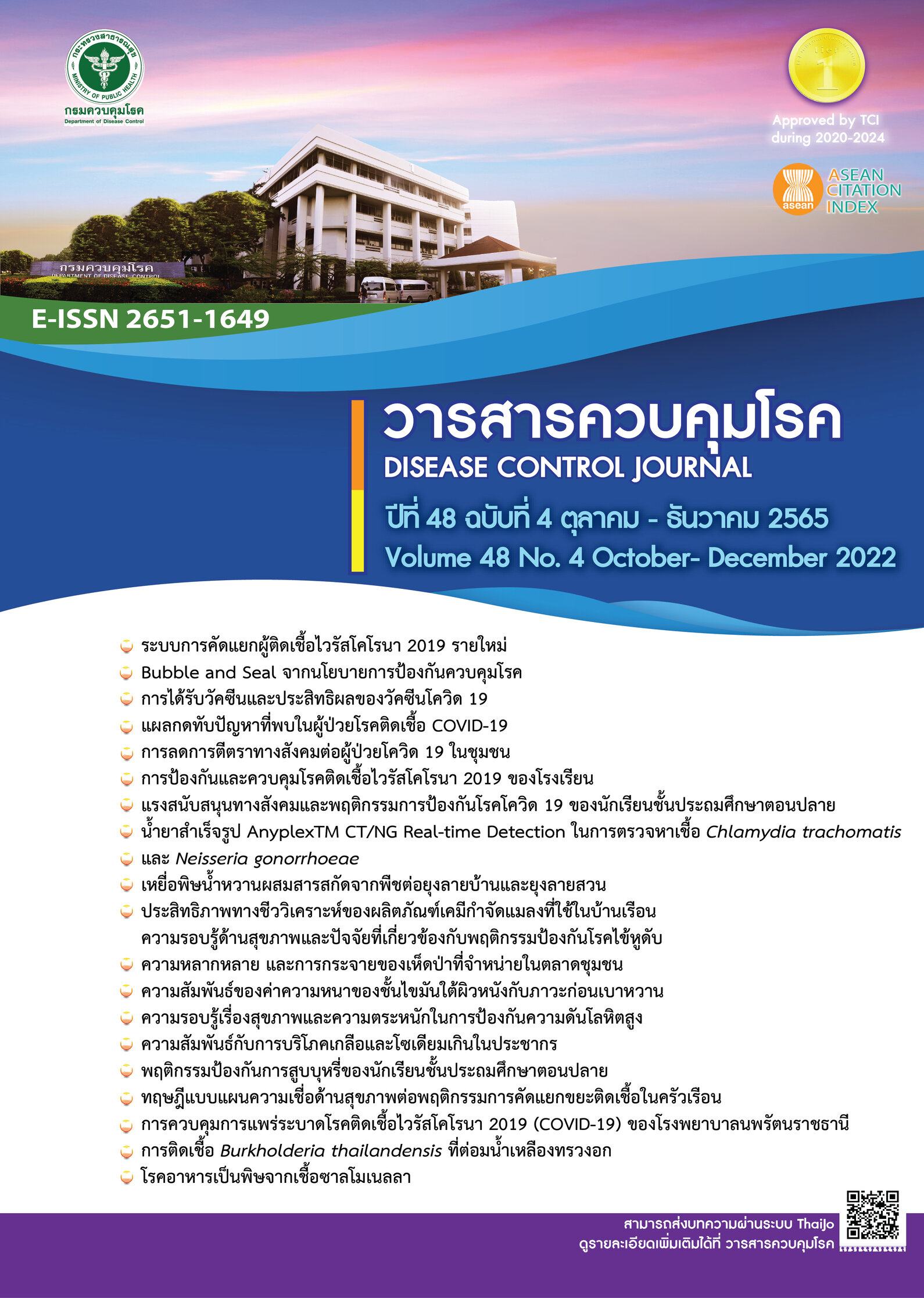The relationship between health literacy and related factors toward Streptococcus suis prevention behaviors among people in Nakhon Sawan Province
DOI:
https://doi.org/10.14456/dcj.2022.70Keywords:
Streptococcus suis disease, Health literacy, Prevention behaviorsAbstract
Streptococcus suis infection is a disease that can be passed from animals to humans caused by bacteria Streptococcus suis. Pigs serve as the most important reservoir. Streptococcus suis disease can create a significant impact on health such as disability, permanent hearing loss, or even death. It mainly caused by the consumption of foods containing pork, pig blood, or pig organs which are uncooked or undercooked. This behavior can be changed, if people have health literacy which is an important tool for health care and prevention. The purpose of this cross-sectional study was to study the level of health literacy of Streptococcus suis disease, the level of preventive behavior of Streptococcus suis disease and factors related to prevention behavior of Streptococcus suis disease. Multistage sampling was performed to recruit 317 participants aged 35-70 years who lived in Nakhon Sawan Province for more than 1 year. Data were collected through a questionnaire and analyzed by using frequency, percentage, mean, standard deviation, Pearson product moment correlation coefficient, Chi-square test and Multiple linear regression. The results showed that most of the participants had fair level of health literacy of Streptococcus suis disease (74.1%) and good level of prevention behaviors on Streptococcus suis disease (56.8%). Factors Influencing preventive behavior of Streptococcus suis disease of people in Nakhon Sawan Province are: understanding about Streptococcus suis and prevention, skill make decisions about Streptococcus suis prevention, The beliefs about raw pork and family member influence had a significant positive correlation with Streptococcus suis prevention behavior(p<0.001). Relevant agencies should engage the results with the planning for Streptococcus suis disease prevention and control to protect the people in Nakhon Sawan
Downloads
References
Chaknum T. Surveillance Guidelines and investigating Streptococcus Suis infection. Nonthaburi: Division of Epidemiology; 2009. (in Thai)
Situation Awareness Team, Office of Disease Prevention and Control 3, Nakhon Sawan Province. Report 506 Division of Epidemiology [Internet]. Division of Epidemiology; 2020 [cited 2020 Aug 30]. Available from: http://odpc3.ddc.moph.go.th/index.php (in Thai)
Investigation team DPC3. infectious disease investigation report Streptococcus Suis [Internet]. Nakhon Sawan: Office of Disease Prevention and Control 3, Nakhon Sawan Province; 2019 [cited 2020 Aug 30]. Available from: https://ddc.moph.go.th/ddce/news.php?news=6758&deptcode= (in Thai)
Khumnurak S, Klinman K. Development of a Learning Model for the Prevention of Streptococcus Suis Infection Among People in Nakhon Sawan Province. Journal of Preventive Medicine Association of Thailand. 2018;8:430-40. (in Thai)
Choeisuwan V. Health Literacy: Concept and Application for Nursing Practice. Royal Thai Navy Medical Journal. 2017;3:183-97. (in Thai)
Nutbeam D. Health promotion glossary. Health promotion international. 1998;13:349-64.
Nutbeam D. Health literacy as a public health goal: a challenge for contemporary health education and communication strategies into the 21st century. Health promotion international. 2000;15:259-67.
Daniel WW. Biostatistics: Basic Concepts and Methodology for the health Sciences. 9th ed. New York: John Wiley & Sons; 2010.
Nakhon Sawan Provincial Statistical Office. Nakhon Sawan Province Statistics Report Year 2019 [Internet]. Nakhon Sawan; 2019 [cited 2021 Jan 20]. Available from: http://nksawan.nso.go.th/images/attachments/article/335/statisticalReport62.pdf (in Thai)
Likert R. The Method of Constructing and Attitude Scale. In: Fishbein M, editor. Readings in Attitude Theory and Measurement. New York: John Wiley & Sons; 1967. P.90-5.
Bloom S. Human characteristics and school learning. New York: McGraw-Hill; 1976.
Roma W, Mukda S, Kloiiam S. Survey project health literacy of Thai people aged 15 years and over, year 2017 (Phase1) [Internet]. Department of Health, Ministry of Public Health; 2017 [cited 2021 Jul 28]. Available from: https://kb.hsri.or.th/dspace/handle/11228/5216 (in Thai)
Takeuchi D, Kerdsin A, Akeda Y, Chiranairadul P, Loetthong P, Tanburawong N, et al. Impact of a Food Safety Campaign on Streptococcus suis Infection in Humans in Thailand. The American Society of Tropical Medicine and Hygiene. 2017;96:1370–7.
Sathawornwiwat A, Kengkanpanich M, Saengrat N, Sangjan J. Factors Predicting Raw Meat Consumption Behavior among People Chiang Klang District, Nan Province. Thai Journal of Health Education. 2020;43:25-37. (in Thai)
Tachavijitjaru C. Health Literacy: A key Indicator towards Good Health Behavior and Health Outcomes. Journal of The Royal Thai Army Nurses. 2018;19:1-11. (in Thai)
Downloads
Published
How to Cite
Issue
Section
License
Copyright (c) 2022 Disease Control Journal

This work is licensed under a Creative Commons Attribution-NonCommercial-NoDerivatives 4.0 International License.
Articles published in the Disease Control Journal are considered as academic work, research or analysis of the personal opinion of the authors, not the opinion of the Thailand Department of Disease Control or editorial team. The authors must be responsible for their articles.






